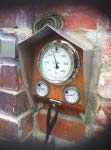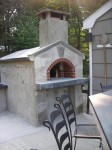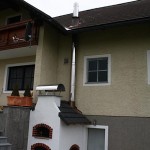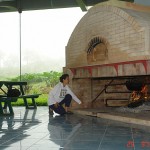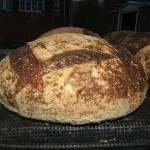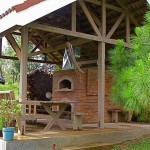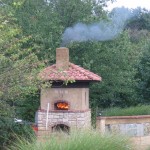Measuring oven temperature
Temperature conditions in wood burning hot pizza - bread ovens. What is the easiest way to control temperature in wood fired brick ovens?
How do I know when is wood burning pizza/bread oven ready for loading?
When I began having thoughts about building and cooking in my own wood burning traditional pizza oven, one of the first questions I had regarding cooking strategies was how will I know the best time to start to put my pots, pizzas, sausages on the hot oven floor.

Great and simple self standing Stainless Steel Oven Thermometer.
Measuring the slow-roasting & baking temperature levels inside ovens with these inexpensive meters is perfect because they are slow responding (e.g. after the oven door was opened, it takes them some time to show the temperature lowering down.)
I knew that first I would set a moderate fire inside the oven's dome using some dry wood or tree branches and so on (but not with paint on them) laying on the old newspaper which I then ignite. After some time, depending on the size of the oven and its dome mass density, normally perhaps close to 1-1/2 hour the oven is ready and waiting for the first meal loads going in to be cooked and/or baked.
Aah, but how do you know it exactly, my oven can be larger or smaller, it can have thin walls or my walls are of a great thickness for much better heat absorption so it cooks for me for a long time. It can have a great thermal insulation application thickness on as well, and a lovely mass within the actuale firebricks - you may ask?

Heat in the oven with its door opened.
The oven is fully ready for baking.
I repeat: it's easy, don't fret! After about an hour or one and half, keeping the fire burning slowly, take a small amount of flour and throw it onto the oven's floor somewhere between the fire and the oven's inside wall or on an available space. Throw it in a patchy scattered way. At the beginning, some places closer to the fire could be hotter then place next to the wall. This will get more even later if you keep a gentle fire going. Fetching me to make a point many people set the fire hours before the time when their friends are coming for a dinner while keeping fire in the oven on low. This way your oven gets hot very evenly, ovens walls absorb (suck up) lots of energy and hold the heat longer.
OK, you may say: "I know how to throw the flour in, but what next?"
Once thrown in, all hell breaks lose (I am just kidding). Watch it for about a minute. When your oven is appropriately hot, the flour will turn to a golden color and then it will start to darken, but not too fast. This is the best temperature inside of the oven, when it's like this you do not have to wait a long time to finish individual meals e.g. pizzas or sausages and the like.
For these, only about 3 minutes or less is required. Roasting chicken, casserole dishes, etc., take a bit longer; you could also rotate/twist it around at times (not necessarily around various oven spots)- it's fun.
Now, if the flour stays white or just slightly-trifles to yellow, the oven is not really ready yet. Pizza would taste soggy rather than how they should look when done in traditional wood burning brick oven - and taste boiled too.
If the flour darkens fast and burns, stop adding more wood to the fire (and if you want to keep having fire for longer it should be small). Be vigilant not to end up with pizzas cooking that have burned edges. Also, for pots, rotate them inside more often and keep then further from the fire spot. Pizza like it hotter and are usually done in 90 seconds! Breads come in on the end when ovens temperature drops down. For bread baking, close the oven using a wooden door soaked in a bucket of water.
Although cooking in wood ovens is much more simple and a lot easier than in conventional ovens and stoves, if you forget about having your favorite cakes inside you know what happens, mixing dough again.
Now you know that controlling temperature in the brick wood oven is very easy and everyone can do it. With a little bit of experience gained, you will have time to mingle more among your friends.
Just forgot to add, there are also very accurate and fancy e.g. analog and digital thermometers on the market.
by Rado Hand
